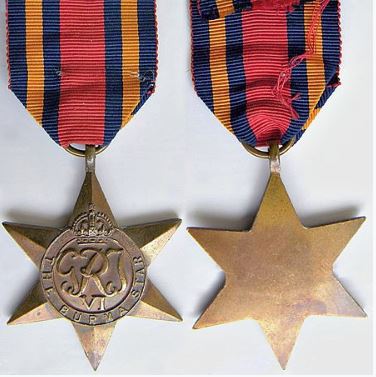Difference between revisions of "Burma Star"
From Our Contribution
(Created page with "{{Infobox | name = Burma Star | title = | above = | subheader = | image = File:Burma_Star.jpg | caption = | image2...") |
(No difference)
|
Latest revision as of 19:45, 14 November 2019
 | |
Eligibility
The Burma Star was instituted by the United Kingdom in May 1945 to acknowledge those who had served in operations during the Burma Campaign from 11 December 1941 to 2 September 1945. Eligibility criteria for the award of the Burma Star were different for service at sea, on land and in the air.
The six months service requirement for the award of the 1939-1945 Star had to be completed before service could begin to count towards qualification for the award of the Burma Star. Air crew engaged in operations against the enemy qualified, provided they had already earned the 1939–1945 Star and had completed at least one operational sortie over the appropriate sea or land area.
Royal Navy and Merchant Navy personnel qualified through serving in either the Bay of Bengal or an area defined by a line running from the southernmost point of Ceylon for 300 miles south, then to a point 300 miles west of the southernmost point of Sumatra and continuing east to the western side of the Sunda Strait, including the Strait of Malacca and then south just west of the Australian coast.
Those whose qualifying service period was terminated prematurely by their death or disability due to service were awarded this Star, and those who entered service with less than 6 months of the war left could qualify for the Burma Star, but not the 1939-45 Star.
Description
The six–pointed star is yellow copper zinc alloy. The obverse has a central design of the Royal Cypher "GRI VI", surmounted by a crown. A circlet, the top of which is covered by the crown, surrounds the cypher and is inscribed "THE BURMA STAR". The obverse or reverse is plain.
Notes
The Burma Campaign took place between 11 December 1941 and 2 September 1945, commencing with Japanese forces invading Burma and driving British forces back to the Indian border. Since the Japanese held superiority in the Pacific, the Allies were not in a position to strike back and regain a foothold in Burma until early in 1944. Total surrender of the Japanese came on 2 September 1945. Content for the history and honours sections has come from a combination of Wikipedia and the Australian War Memorial websites.